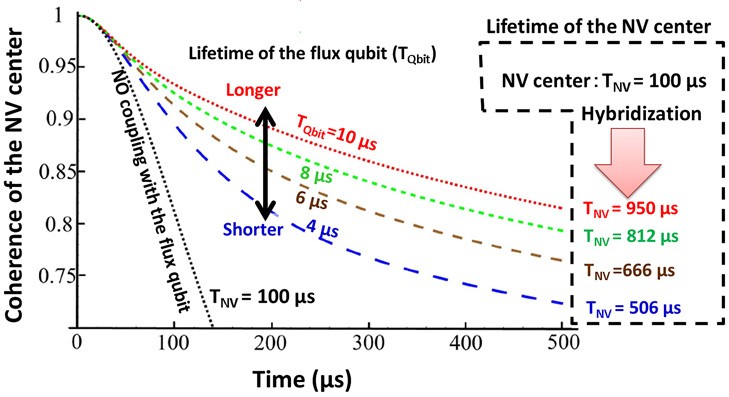Improving the Coherence Time of a Quantum System by Coupling it to a Short-lived System
A single nitrogen-vacancy (NV) center is a promising candidate to realize quantum information processing [1]. However, it is known that low frequency magnetic field noise decreases the coherence time of the NV center [2].
We theoretically show that coupling an NV center with a short-lived superconducting flux qubit (FQ) improves the coherence time of that NV center [3]. The NV center has two excited states. One of them is called a bright state coupled with the FQ while the other one is called a dark state decoupled from the FQ. Since these two excited states are degenerate without the FQ, low frequency magnetic field noise can cause stochastic transitions between them, and this decreases the coherence time of the NV center. However, if the NV center is coupled with the FQ, these two excited states are energetically separated due to the coupling. There is an energy gap between the bright state and dark state, and so the transition between them by the low frequency magnetic field noise is suppressed. This improves the coherence time of the dark state. From numerical simulations, we have confirmed that a flux qubit with a coherence time of 10 µs can improve the coherence time of the NV center from 100 µs to nearly 1 ms via the coupling (Fig. 1). Our proposal opens a new way to use a quantum hybrid system for the realization of robust quantum information processing.
- Present address: *Chinese Academy of Sciences
- [1] C. Degen, Nature Nanotech. 3, 643 (2008).
- [2] D. Lange et al., Science 330, 6000 (2010).
- [3] Y. Matsuzaki et al., Phys. Rev. Lett. 114, 120501 (2015).

|
| Fig. 1. Numerical simulation of the decoherence behavior of the NV center with and without coupling to the FQ. Here, the horizontal axis denotes the time and the vertical axis denotes the coherence of the NV center. |